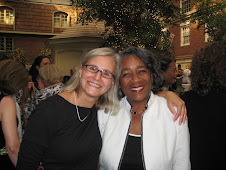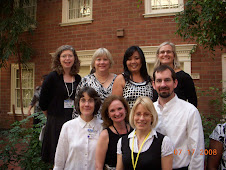Tuesday, October 7, 2008
A to Z Taxonomy
With Animal Dreams by Barbara Kingsolver in English 10 the students went through the steps of creating a personal taxonomy, sharing ideas in a small group, reporting to the full class, and then composing with key words to get a start on their literary analysis essay.
To report a word for the taxonomy to the class, students used an oral speaking frame that stated: "I have a/an ____ to contribute to the "Search for Self Taxonomy" and it is _________ because Kingsolver believes ______________ about finding yourself, and this word represents _____________________."
The depth of the student reports when adding to the taxonomy were deeper than I have ever seen with the taxonomy, and many of the words that students shared were symbolic. In fact, the taxonomy finally allowed students to see symbols that they had been struggling understanding prior to the taxonomy.
The amazement with the taxonomy's success was reiterated by English 10 teacher Rachel Tholen, who reported: "The kids are creating their taxonomies. It’s amazing. It’s the best thing we’ve done with this book so far. I’m a total convert to the taxonomy."
Rachel emailed again after another successful class period, stating: "I know I’m a broken record on the taxonomy, but my sophs are finishing up our discussion on the search for self taxonomy today, and I can’t believe how well it works. It may be the perfect way to teach symbol. My second hour had some thoughtful things to say about the afghan, and how it represents comfort and safety for Codi, but also how it's woven together by Uda, and how the older women in the community weave together the relationships, past, and history of the town and the people in it."
Kristin Benson also reported that the taxonomy worked well to discuss the rebel theme in Catcher in the Rye.
Tuesday, May 6, 2008
Displaying Student Work

Idealistic Leader Traits
Not only have these discussions of idealist traits helped KC build relationships with her students, but also students have reported that they have used information from classroom discussions outside of class, even at job interviews.
The idealistic leader traits from Admission Possible are:
"Strive to be DELIGHTFUL!
ENERGIZE those in your presence.
Keep your EYES ON THE PRIZE.
CHALLENGE CYNICISM whenever you encounter it.
MOCCASIN the lives of others. Imagine life in someone else's moccasins.
Learn to be GRATEFUL.
HAVE FUN!"
Visit Admission Impossible for more information on the Idealistic Leader Traits.
Wednesday, January 30, 2008
Great Gatsby Introduction
I may use some of Rob’s quotes from the paper, write them on newsprint and have kids circulate around the room with them. I’ll ask kids to write a few sentences about the one quote that resonates with them. (Moving Quotes strategy)
Then I think I’ll do a circle frame map on the American Dream and ask kids to generate a 1-2 sentence definition after they've completed their circle map . Once they have their definitions I’ll ask them to draw a picture that is symbolic of their understanding of the American Dream. We can then post some of these.
For some background on the 1920’s/ Fitzgerald/ Gatsby: I think I’ll lecture a bit on Monday and then we’ll develop individually and as a class an A to Z taxonomy for this background information to review what they learned from the lecture.
Tuesday, December 18, 2007
Writing and Thinking
That statement equating thinking and writing started me on my quest to explore writing connections in the books that I had received from NUA. Although I had used or seen many of the strategies modeled, I had not scanned the books with a "writing and thinking" lens. I got some great ideas that I could pass on to teachers who had specific questions about teaching writing. Below is a summary of my findings:
Student Successes in Thinking Maps
Buckner's chapter in Student Successes in Thinking Maps called “Empowering Students from Thinking to Writing” specifically addresses how to help students write a non-plagiarized, authentic research paper. Buckner advocates the use of the tree map or flee map for note taking. English 10 teachers had great luck with the flee map last year during the research paper unit to help students organize their research findings before writing their paper.
In addition to tree or flee maps for note taking, Buckner states that teachers can help students with disorganized papers through a process of “reverse mapping.” Basically, students cut apart their paper and try to fit their sentences into a flee map. Reverse mapping also allows students to see any holes that they have in their paper.
Thinking Strategies for Student Achievement
Denise Nessel’s book, Thinking Strategies for Student Achievement, has a wealth of writing strategies. Here is the briefest of summaries of writing-relevant chapters:
Cubing (p. 39): Chapter 5 describes this strategy which allows students to think about a topic from multiple perspectives (describe, compare/contrast, associate, analyze, apply, and argue for/against). This strategy increases students' fluency on a topic and helps them learn the cognitive clues that are often used in essay questions.
Freewriting (p. 67): Chapter 9 discusses a long-time favorite strategy for English teachers that involves students writing for a sustained period of time without stopping. This technique is a great tool for generating ideas and overcoming writer's block.
I-Search Reporting (p. 81): Chapter 12 includes a number of follow-up questions that teachers can ask students to make research paper topics relevant to their lives by having students formulate questions that are related to their concerns and pursuits.
Imitation Writing (p. 87): Chapter 13 outlines this strategy which involves taking a known work or famous quotation and substituting words while maintaining the text's structure.
Journal and Learning Logs (p. 101): Chapter 15 includes a number of journal writing prompts not only for English teachers but also for math, social studies, and science logs.
Key Word Notes (p. 109): Chapter 16 details this strategy that many Edina teachers use for lectures, readings, films and classroom discussions. Key Word Notes is a quick and efficient information gathering strategy if students need to write an essay after a reading selection as part of an exam. To learn about more applications of this strategy, click on "Key Word Notes" under "NUA Topics Discussed on This Blog."
Paraphrasing (p. 141): Chapter 21 discusses how teachers should start students with paraphrasing of texts that students can’t copy—e.g. videos, the teacher reading aloud. Then students can progress to reading, putting down the text, and taking notes.
Saturation Reporting (p. 171): Chapter 27 discusses this eye witness written report based on intense observations of a certain location and/or event. These reports become detailed, sensory descriptions.
Writing Frames (p. 187): Chapter 30 of Nessel's book summarizes the strategy of using frames (text structures with blanks to be filled in) that is detailed in Writing as Learning by Andrew and Evelyn Rothstein.
Sample Descriptive Writing Lesson: On p. 171, Nessel outlines a writing lesson that incorporates a number of strategies previously mentioned in her book.
Thinking Maps: Tools for Learning
David Hyerle's Thinking Maps binder has many ideas for prewriting and essay organization. The "Teaching" section of the binder shows how each map can be used for prewriting an essay, and an essay prompt is included. Also, pages 3-17 and 3-24 have writing starter patterns.
If students learn cognitive clues in essay questions, they will be able to select the appropriate Thinking Map for organizing their ideas. For example, Thinking Maps are associated with the following expository text structures:
1) sequence is flow map
2) double bubble is compare and contrast
3) multi-flow is cause and effect
4) circle map or bubble map for describing
5) problem/solution involves multiple maps (circle map to define, double bubble to compare to possible solutions)
Writing as Learning
Andrew Rothstein, Evelyn Rothstein and Gerald Lauber's book Writing as Learning includes a number of strategies to assist with writing across the curriculum. The book discusses how the A to Z Taxonomy can be used both to engage students and to help them organize their ideas for writing. Chapter 7 "Profiles and Frames: Organize Your Writing" and Chapter 9 "Reasons, Causes, Results--The Basis of the Essay" appear to be the most relevant chapters to assist teachers with high school essay writing.
Sunday, September 23, 2007
A to Z Taxonomy
Strategy steps:
- The teacher gives the unit's theme to the students. The theme needs to be broad enough and real-life enough that students can use their prior knowledge and cultural background to complete the task.
- This tasks works best in groups to really build excitement.
- The group's recorder starts lettering a large sheet of paper with A, B, C, D . . . . X, Y, Z.
- Group members create a list of words that they think are examples of the main theme or illuminate the theme in some way.
- Students do not need to progress sequentially through the alphabet. They just fill in the blanks as they think of words or phrases that start with a given letter.
- If students have difficulty completing the list, the teacher may allow one member per group to wander around the room for one minute and "spy" on other posters being created.
- The teacher may or may not allow the use of a dictionary and a thesaurus.
- Once all groups are completed, then the teacher may have people share their lists with the full class or have the class come up with an agreed-upon word or phrase for each letter.
I’ve had equal success with this activity with the word “relationship” with Othello. At the end of the Othello unit, students revisited their A to Z Taxonomies to see if Shakespeare had addressed all of their relationship words. With a little creativity and successful use of synonyms, students found that they could find an example from Othello for each word in their A to Z Taxonomy. Students really learned that Shakespeare is timeless and universal.
I will have students revisit their Brave New World Science and Technology lists too. They will then evaluate just how much of a futurist Aldous Huxley really was.







